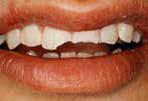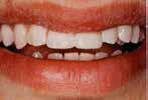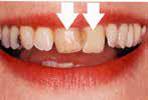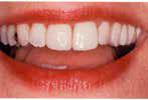Veneers can restore your teeth to a neat, natural appearance. They fill in gaps, repair broken teeth and whiten discoloured teeth, beautifying your smile in the process. Here at Tandzorg Kralingen in Rotterdam, we can fit new veneers and are also happy to help you replace existing ones.
Would you like to find out more about veneers, or arrange an appointment with the dentist? Please contact us.
A dentist in Rotterdam who you can rely on.
At Tandzorg Kralingen, all our dentists are registered with the Quality Register for Dentists (KRT). This demonstrates that our dentists are qualified and competent. In order to maintain this registration, our dentists must meet a number of standards. This means that our dentists:
- Make sure you are certified and have a valid BIG registration.
- Take refresher courses to stay up to date in your profession.
- Work according to practical guidelines.
- Be open and accountable to colleagues and patients.
- Speak Dutch fluently.

I am very happy with this dentist! You are not pressured into unnecessary costs, such as X-rays, which has often happened at other practices I have been to. This dentist has also managed to create two beautiful teeth, which my previous dentist said would be impossible. I was also helped the next morning when I had an emergency. 🙂 — Nerissa Teeuwen
Rest assured that at Tandzorg Kralingen, you will be treated by dentists who adhere to the highest quality and professional standards.
Get veneers for a complete, radiant smile!
Veneers are the solution for gaps, chipped corners or uneven teeth. They quickly and effectively repair or eliminate imperfections, resulting in teeth that look natural and well cared for.
Before-and-after photos of veneers.




What is the process for getting veneers?
The treatment method for veneers varies depending on the material used. A composite veneer can be applied in a single treatment, whereas a porcelain veneer requires at least two visits to the dentist, since the veneer must be made by a dental laboratory. Read about our patients’ experiences with veneers on the Veneer Experiences page.
Treatment with composite veneers
The treatment for a composite veneer involves the following steps:
- Choosing the colour of the veneer
Your dentist will consult with you to determine the right colour. In many cases, they can show you the effect of your chosen colour immediately. - Grinding the tooth
If necessary, they will grind away a thin layer of the tooth’s surface to create space for the veneer. - Shaping the veneer
After grinding, the dentist will treat the tooth with acid and apply an adhesive layer. The composite veneer is then placed on top of this. - Shaping the veneer
During the final step of the treatment, the dentist shapes the composite veneer into the correct form. They then shine a blue light on it to harden the composite.
Porcelain veneers treatment
Treatment for porcelain veneers is different and consists of the following steps:
- Choosing the colour of the veneer
The dentist will consult with you again to determine the right colour. The veneer will then be manufactured by the dental laboratory. - Grinding the tooth
When using a porcelain veneer, the dentist often has to grind away more of the tooth than with a composite veneer, including the enamel. This is because a porcelain veneer must be at least half a millimetre thick. - Shaping the veneer
The dentist takes an impression of the tooth, after which the veneer is custom-made by the dental laboratory. - Applying the veneer
Once the veneer has been manufactured, you will need to come to the practice for a second appointment. During this appointment, the dentist will bond the veneer to the tooth using an adhesive.
But what exactly is a veneer?
A veneer can be made from a tooth-coloured composite filling material or porcelain. Dentists can use both to improve the appearance of teeth by bonding them to real teeth.
Veneer made of porcelain
Porcelain veneers have the advantage of being much less susceptible to staining from coffee and tea than composite veneers, for example. Porcelain veneers also tend to produce a more aesthetically pleasing end result.
Composite veneer
Composite veneers require less of the natural tooth to be ground away than porcelain veneers. The outcome of composite veneers is also more predictable.
What are the costs of veneers?
The material used for the veneer has a significant impact on the final cost. For example, the cost of a composite veneer is considerably lower than that of a porcelain veneer. The cost of a porcelain veneer is higher than that of a composite veneer due to the material used and the labour-intensive work of the dental laboratory. You can expect the following costs:
| Description | Costs of veneers |
|---|---|
| Composite veneers | € 100,- – € 150,- per tooth |
| Porcelain veneers | € 450,- – € 900,- per tooth |
Make sure you are well informed and ask your dentist for a cost estimate for the veneer(s). You can find more information about veneer costs on the Veneer Costs page.
Reimbursement for veneers
Basic insurance does not cover the placement of veneers. Do you have additional insurance? If so, you may be entitled to full or partial reimbursement. Contact your health insurer for more information.
Contact
Tandzorg Kralingen
Voorschoterlaan 31a
3062 KG Rotterdam
Opening hours
Monday:08.15 – 17.00
Tuesday:08.15 – 17.00
Wednesday:08.15 – 17.00
Thursday:08.15 – 17.00
Friday:08.15 – 17.00
Saturday:By appointment
Sunday:Closed
Frequently asked questions about veneers
We have answered a number of frequently asked questions about veneers below. If you cannot find the answer to your question below, please feel free to contact us.
How long do veneers last?
On average, a veneer lasts between five and ten years. However, this depends on your lifestyle: for example, discolouration occurs more quickly if you drink coffee or tea or smoke. Veneers also wear out or become damaged more quickly if you grind your teeth or bite your nails.
Is veneering suitable for everyone?
Provided your gums are healthy, it is usually possible to have veneers fitted. However, veneers are not recommended for people who bite their nails or grind their teeth, as this can cause them to wear down and become damaged more quickly.
Can I eat anything with a veneer?
With a veneer, you can eat and bite normally. However, you should be careful when biting hard things, such as nuts, sour candies, or pens.
Is it painful to have a veneer placed?
Having a veneer placed is usually painless. For example, when grinding enamel, the dentist does not go as deep as when drilling a tooth. However, it is sometimes necessary to repair your tooth first. If this is the case, you can be treated under local anaesthetic.
Are there any risks involved in placing veneers?
The tooth may be slightly more sensitive to temperature changes immediately after the veneer is placed, but veneers do not normally cause any complications or risks.
Contact Tandzorg Kralingen in Rotterdam
Would you like any more information about veneers, or would you like to arrange an appointment at Tandzorg Kralingen? You can either call us on 010 414 2248 or book an appointment online.




